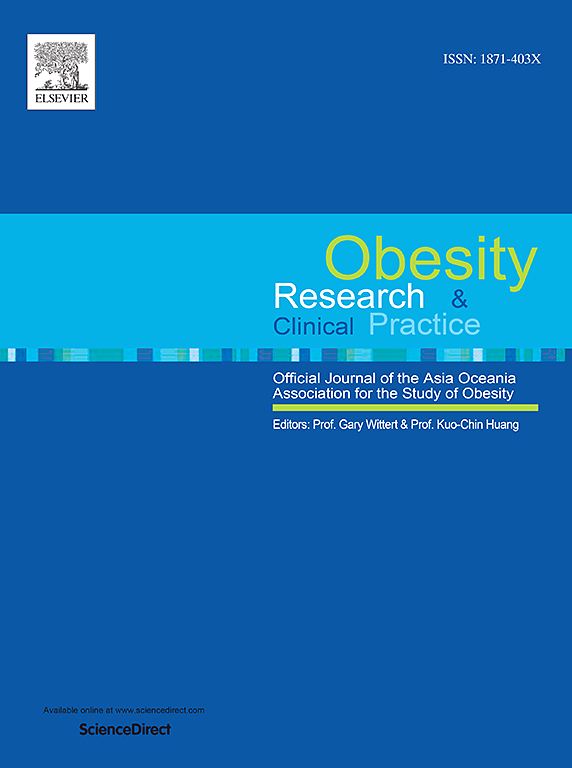The Asia–Oceania consensus: Definitions and diagnostic criteria for sarcopenic obesity
IF 2.5
4区 医学
Q3 ENDOCRINOLOGY & METABOLISM
引用次数: 0
Abstract
Objective
The aim of this study was to develop consensus definitions and diagnostic criteria for sarcopenic obesity tailored to Asia-Oceania populations, a condition characterized by reduced skeletal muscle mass and function with excess adipose tissue.
Methods
Experts from various fields formed a working group under the Asia–Oceania Association for the Study of Obesity (AOASO) and the International Association of Gerontology and Geriatrics Asia/Oceania Region (IAGG-AOR). The group convened four meetings, employing the Delphi technique to achieve consensus on diagnostic criteria and management strategies for sarcopenic obesity.
Results
The consensus defines sarcopenic obesity with a 3-step algorithm, including screening, diagnosis, and intervention. The screening criteria included BMI and waist circumference for obesity and calf circumference, the SARC-F, and the Finger Ring test for sarcopenia. The diagnostic criteria for sarcopenia include assessments of muscle mass (using dual-energy X-ray absorptiometry or bioelectrical impedance analysis), muscle strength (handgrip strength), and physical performance (gait speed, Short Physical Performance Battery, or the 5-Times Sit-to-Stand Test). Central obesity is the main concern for the diagnosis of obesity. The working group recommends a combination of dietary consultations, increased physical activity, resistance training, and the potential use of oral nutritional supplements and medications for managing sarcopenic obesity. The primary objective is to increase skeletal muscle mass and reduce adipose tissue mass.
Conclusions
The established criteria facilitate early recognition and management of sarcopenic obesity, highlighting the need for tailored interventions. Future research should focus on the long-term outcomes of these interventions and the development of pharmacological treatments.
亚洲-大洋洲共识:肌少性肥胖的定义和诊断标准。
目的:本研究的目的是制定针对亚洲-大洋洲人群的肌少性肥胖的共识定义和诊断标准,这种疾病的特征是骨骼肌质量和功能减少,脂肪组织过多。方法:来自不同领域的专家组成了亚洲-大洋洲肥胖研究协会(AOASO)和国际老年学和老年病学亚洲/大洋洲地区协会(IAGG-AOR)下的工作组。该小组召开了四次会议,采用德尔菲技术对肌肉减少性肥胖的诊断标准和管理策略达成共识。结果:共识定义了肌肉减少型肥胖的三步算法,包括筛查、诊断和干预。筛选标准包括BMI和腰围,肥胖和小腿围,SARC-F和手指环测试肌肉减少症。肌少症的诊断标准包括评估肌肉质量(使用双能x线吸收仪或生物电阻抗分析)、肌肉力量(握力)和身体表现(步态速度、短体能表现电池或5次坐立测试)。中心性肥胖是肥胖症诊断的主要关注点。工作组建议结合饮食咨询、增加体力活动、抗阻训练以及可能使用口服营养补充剂和药物来控制肌肉减少性肥胖。主要目的是增加骨骼肌质量,减少脂肪组织质量。结论:所建立的标准有助于对肌肉减少型肥胖的早期识别和管理,强调了量身定制干预措施的必要性。未来的研究应侧重于这些干预措施的长期结果和药物治疗的发展。
本文章由计算机程序翻译,如有差异,请以英文原文为准。
求助全文
约1分钟内获得全文
求助全文
来源期刊

Obesity research & clinical practice
医学-内分泌学与代谢
CiteScore
7.10
自引率
0.00%
发文量
80
审稿时长
49 days
期刊介绍:
The aim of Obesity Research & Clinical Practice (ORCP) is to publish high quality clinical and basic research relating to the epidemiology, mechanism, complications and treatment of obesity and the complication of obesity. Studies relating to the Asia Oceania region are particularly welcome, given the increasing burden of obesity in Asia Pacific, compounded by specific regional population-based and genetic issues, and the devastating personal and economic consequences. The journal aims to expose health care practitioners, clinical researchers, basic scientists, epidemiologists, and public health officials in the region to all areas of obesity research and practice. In addition to original research the ORCP publishes reviews, patient reports, short communications, and letters to the editor (including comments on published papers). The proceedings and abstracts of the Annual Meeting of the Asia Oceania Association for the Study of Obesity is published as a supplement each year.
 求助内容:
求助内容: 应助结果提醒方式:
应助结果提醒方式:


